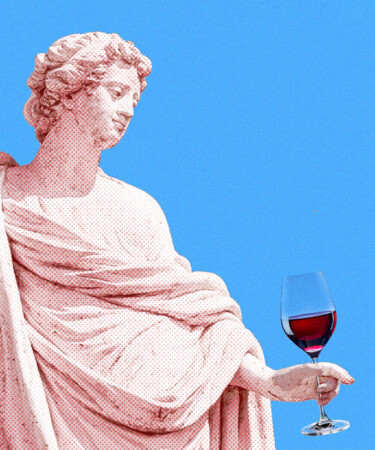Ancient Rome was in a nebulous state throughout its existence. From roughly 800 B.C. all the way up to the Roman Empire’s collapse in 476 A.D., the area that qualified as Rome stretched from parts of Africa through most of Europe and even the Middle East. Viticulture was bubbling up through Greece and Italy, eventually making its way to the rest of the far-off Roman territories. And, much like the empire’s landscape and politics, its drinking habits were volatile and constantly changing.
Most Greeks drank in moderation around 450 B.C., with the exception of people who worshiped at the bacchanalian altar of Dionysus. Writers were advocating wine’s supposed medicinal properties, suggesting that it helped with snake bites, stomach issues, gout, and, ironically enough, memory loss. Philosophers like Plato even proposed drinking ages. By the late second century B.C., winemakers tapped into the Mediterranean basin. Southern Italy’s indigenous vines provided the prime opportunity for wine production, so much that Greeks started referring to the region as Oenotria, meaning the Land of Vines. This created a perfect storm for wine to become much cheaper and widely available. At this point, wine consumption was roughly 250 liters per year per capita.
But as the Republic fell and the Roman Empire came into power in 31 B.C., intoxication was ramping up. The export of Italian wine became increasingly lucrative, with wine even making it up to Albion, the land we know today as the U.K. By the first century A.D., Roman citizens and soldiers were each drinking 100 gallons of wine per year. One hundred gallons is 378.5 liters, and the average bottle of wine is .75 liters. That equates to 1.04 liters — or over a bottle — per day. It’s said that the Romans even started to encourage binge drinking and intoxication: They drank before meals, vomited so they could eat and drink more, and even played simple drinking games, one allegedly involving rolling dice and chugging however many cups of wine the dice dictated.
By roughly 40 A.D., alcohol abuse had reached its peak. Everyone from the emperors to their slaves were getting their drink on. Wine was abundant enough to be given away for free, often flowing without charge at festivals and victory celebrations. Romans began mixing lead with wine through the practice of boiling grape must in lead vessels. The lead gave wine a sweet taste and, supposedly, a pleasant mouthfeel. This, along with lead plumbing and lead utensils, is said to have caused lead poisoning. Nonetheless, wine production was in full swing. Roman historians like Pliny the Elder — who would one day inspire the name for one of the world’s most sought-after beers — started writing about terroir and even ranking wines.
Some experts say that in the centuries that followed, religion could have played a role in the reduction of Roman wine consumption. Both the New and Old Testaments glorified wine but condemned inebriation, advising anyone who couldn’t control their drinking habits to abstain altogether. That, as many know, is a hard line to walk. And while the society’s interest in wine and viticulture was obvious, flip-flopping laws and vacillating attitudes around drinking culture hindered momentum. By 300 A.D. Roman Emperor Theodosius implemented the death penalty for anybody who destroyed vineyards, which had become a popular practice due to high tax rates. And about 50 years later, viticulture began near Paris.
By then, the Roman Empire was already beginning to fall apart, and the infrastructure necessary to produce and move its wine crumbled in the wake of war, disease, and economic depression. The Western Roman empire ceased to exist as a single polity over the course of the next century, giving way to the Middle Ages in an isolated and rural Europe. To recall the rollicking, heavy-drinking days of the Roman Empire, we look to the epitaph of Roman eques Tiberius Claudius Secundus: “Baths, wine, and sex corrupt our bodies, but baths, wine, and sex make life worth living.”
